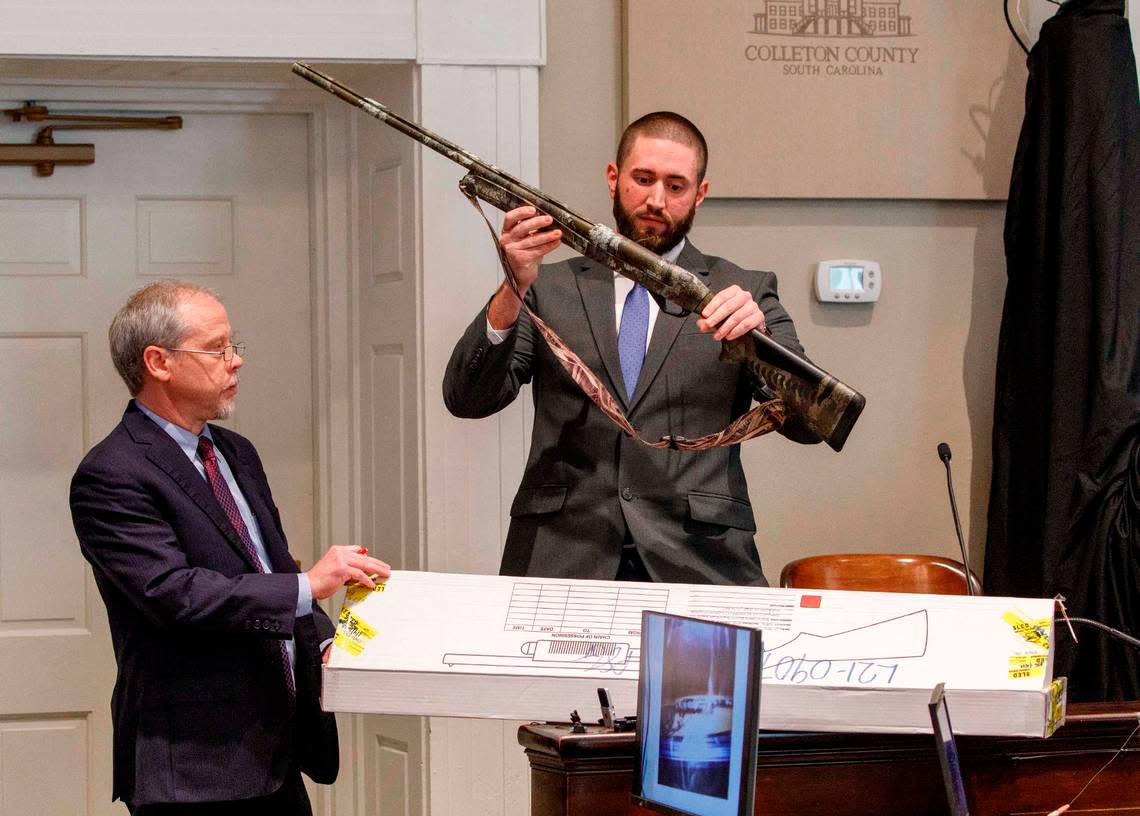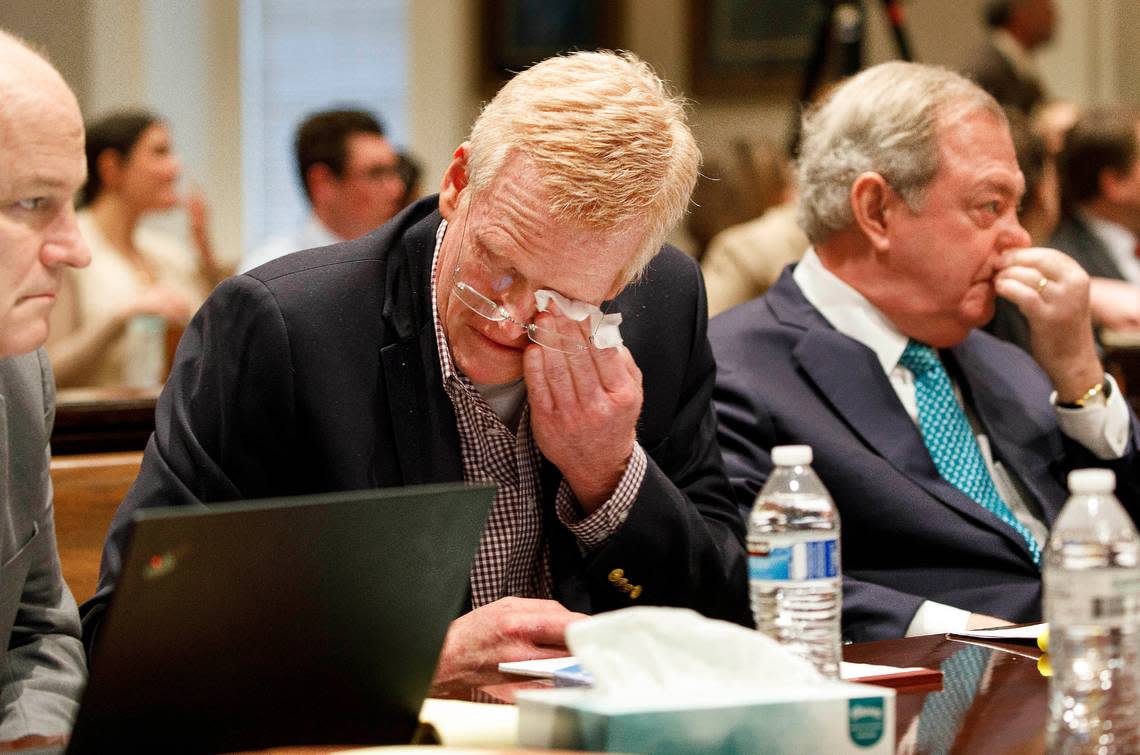‘Pools of blood’: Jurors watch drone video of crime scene at Alex Murdaugh murder trial
Editor’s note: The following story contains graphic details of murder that may be inappropriate for some readers.
Jurors on Thursday heard directly from Alex Murdaugh.
His voice came to them from the night his wife, Maggie, 52, and son, Paul, 22, were shot, via a 911 emergency line call from the crime scene and law enforcement body camera footage from the first responders who arrived at the scene of the murders the night of June 7, 2021.
The recordings captured Murdaugh’s high-pitched wails, and the near ceaseless barking of the Murdaugh family’s penned-up hunting dogs in their kennels, near where the killings took place.
It was the first day of witness testimony in the hotly anticipated murder trial in Walterboro, and the first time jurors saw footage of the scene for themselves, taken by law enforcement drones that flew over the property.
Although the audio could be heard by the public in the courtroom, no images could be seen by the public or news media. On Thursday morning, Judge Clifton Newman, who is overseeing the trial, issued an order sealing graphic exhibits, preventing them from being released during the trial and possibly afterward. Some non-graphic images were to be released Thursday night.
Six law enforcement witnesses, including the first officers to arrive at the scene, their commanding officer and 911 operators, took the stand throughout the day. They were the prosecution’s initial offerings in a trial that is expected to last three weeks and have dozens of witnesses as the state tries to build its case that no one but Murdaugh could have killed his wife and son on the family’s remote, sprawling estate.
Three different prosecutors — Creighton Waters, Savanna Goude and David Fernandez — questioned the state’s first half doze witnesses, drawing out facts that supported the state’s narrative of the case. They were all cross examined by Murdaugh’s defense attorney, Dick Harpootlian, who elicited answers that generally supported Murdaugh’s version: That he came upon the bodies, was devastated and does not know who killed them.
Under questioning by both prosecution and defense, law officers agreed that Murdaugh was highly upset.
“He was breathing heavily.... his facial expression was that of torment,” testified Colleton County Sheriff’s Capt. Jason Chapman. “I didn’t see him cry. Not everyone cries.”
But Chapman also testified that Murdaugh’s behavior at times appeared bizarre that night, for instance when he appeared more fixated on his son’s dead body than on his wife’s.
At times Chapman gave highly detailed descriptions: the night of the killings, it was “hot, sticky, 79 degrees, 89 percent humidity,” with “an occasional rain drop and a little foggy.” A storm was on the way.
Witnesses added new information to the sketchy portrait of the death scene available to the public so far in the case: Both Paul and Maggie Murdaugh were found yards apart. Each was lying face down in a broad pool of blood. Both had severe head wounds. Paul had his hands under his body. Paul’s cell phone was lying outside of his back pocket.
“Both had head injuries that were not compatible to life,” Colleton County Fire-Resue Chief Barry McRoy testified, explaining to the jury that was one of his first observations on arriving.
In his cross-examination of Colleton County Sheriff’s Capt. Jason Chapman, Harpootlian asked him whether he was aware of a public statement by law enforcement issued the day after the killings that said the public did not need to be concerned about any danger to the public.
“I am not aware of that,” Chapman testified.
Harpootlian had said he will show that law enforcement focused from the beginning on Murdaugh as the killer and never seriously looked at any other possible suspects.
Thursday’s main court battles occurred over law enforcement’s evidence collection, and whether Murdaugh appeared distressed and covered in blood.
On the stand, state witnesses, some in uniform, described working diligently to secure evidence before an impending rainstorm ruined the scene. On cross examination, Harpootlian asked probing questions about best practices and where first responders and investigators walked in order to argue that the scene was contaminated from the moment law enforcement arrived.
The state’s first witness, Sgt. Daniel Greene with the Colleton County Sheriff’s Office, was the first to arrive at Moselle the night of the killings. On the stand, Greene recounted pulling up to the darkened kennels in his patrol vehicle at 10:26 p.m. where he found the bodies and a distraught Murdaugh. Murdaugh’s black Chevy Suburban was parked nearby with its blinkers on, a shotgun leaned up against its side. Dogs barked and whined in the background.

Jurors watched Greene’s body camera footage from the scene of when he arrived at the dog kennels and found found Maggie and Paul each laying in what he described as a “pool of blood.”
On the radio, he can be heard telling his dispatcher that there appears to be a “whiskey mike” and “whiskey foxtrot” — white male and white female — lying dead on the ground.
Greene testified that, upon walking up to the scene, Murdaugh “immediately started talking about an incident his son was involved in with a boating accident,” which Greene had not yet asked him about.
In 2019, there was a boat that crashed in Colleton County waters, in which Paul’s friend Mallory Beach was killed. The case was the subject of a lawsuit and had created tensions in the Murdaughs’ small community. Paul was facing felony charges and many initially speculated the crash may have had something to do with the murders.
“This is a long story, my son was in a boat wreck a few months back, he’s been getting threats. Most of it’s been benign stuff we didn’t take serious,” Murdaugh told Greene. “You know he’s been getting like punched. I know that’s what this is.”
Greene began to ask Murdaugh what happened and quickly checked him for weapons. Murdaugh told him that there is a shotgun leaned up against the side of his black Chevy Suburban.
Greene placed the 12-gauge shotgun — which Murdaugh said he grabbed from the house upon finding the bodies — in his car. In front of the jury, Waters handed Greene the gun, patterned in green forest camouflage, to inspect. In his cross-examination, Harpootlain asked Greene whether he knew that the 12-guage shotgun was loaded with a Winchester 16-guage shotgun round at the time.
During his opening statement, Harpootlian argued that the fact that an experienced hunter like Murdaugh loaded a shotgun with the wrong ammunition was proof of his distraught and frantic mental state.
Murdaugh’s demeanor in the early hours of the investigation was a focus of questioning on both sides. Captain Jason Chapman, the prosecution’s last witness of the day who arrived at the scene after Greene, said that while Murdaugh “did appear very upset, heavy breathing, distraught” there was a noted change of demeanor when investigators began to inspect a set of tire marks.
“(He) began to watch us work more closely, sometimes out of the corner of his eye,” Chapman said. “After we moved away from the tires the demeanor changed, turned back to upset.”
Harpootlian asked whether Murdaugh’s behavior could be explained “that he thought you had some evidence to point toward the killer and killers?”
Chapman said he couldn’t say why Murdaugh’s behavior changed. It was just “a very noticeable change of demeanor.”
At times during the day’s testimony, Murdaugh could be seen weeping at the defense table, and his attorneys periodically covered displays of the crime scene photos in front of him.
Casings found that match a ‘rifle purchased by Murdaugh.’ Was it a murder weapon?
A second witness testified Thursday, Colleton County Sheriff’s Office deputy Chad McDowell, who is also a K-9 handler. McDowell was the second person who arrived at the scene the night of the shootings. On the body camera footage shown in the courtroom, Murdaugh pauses while identifying his deceased wife to offer a friendly sounding, “Hey, how you doing?” to McDowell.
In testimony, McDowell, who first identified the .300 Blackout shell casings on the ground around Maggie’s body, said that Murdaugh appeared “upset.” Greene described how he started placing little pieces of torn up crime scene tape next to important pieces of evidence. The deputy described it as a standard practice by first responders before crime scene investigators could arrive to mark evidence with placards.

Greene noted several sets of tire tracks on the scene, saying it appeared more activity had taken place that night than Murdaugh “just leaving for the house and coming back.”
When asked about it, Murdaugh can be heard saying only two of the tracks were his.
While searching Paul’s body, the deputies searched for a possible weapon under the body, “to rule out the possibility he had killed Maggie and then himself,” Greene said.
Greene said Murdaugh was “very concerned” that first responders check Maggie and Paul for signs of life, despite the deputy’s assessment that they were dead.
Who is Clifton Newman? Meet the judge presiding over Alex Murdaugh’s murder trial
Murdaugh told the deputy that earlier that night, he had gone to see his mother, who has Alzheimer’s, and asks the deputy whether his wife and son were hurt. The deputy confirmed that they were dead.
“Any reasonable person who came upon those bodies would have come to the conclusion they were deceased,” Greene told the court.
Defense questions evidence collection
Harpootlian questioned Greene and McDowell about whether deputies alerted SLED investigators to tire marks or bloody footprints; whether they had put up high intensity lights that might have made more evidence visible, or whether they had taken sufficient care not to trample over a bloody and confusing scene.
The failure to do this may have prevented other suspects from surfacing, Harpootlian implied.
Harpootlian latched onto the tire tracks seen by first responders that night. Greene said he could not tell whether the tracks were made by one or multiple cars. Greene also said he didn’t know whether the tracks were preserved by first responders or photographed for evidence. He said he didn’t ask for either to be preserved or photographed because it was not his responsibility.
“No expert could have looked and said that’s a suburban, that’s a pickup truck?” Harpootlian said.
Under redirect from the prosecution, Greene said the deputies there followed standard procedure for protecting a crime scene. Waters also replayed a portion of the body camera footage, where Murdaugh can be heard identifying the tire tracks as his.
But Harpootlian dug in, questioning every witness at the scene about where they had walked and what precautions they had taken to ensure they didn’t contaminate the scene. Greene admitted that neither he nor the deputies under his command wore boots covering their shoes at the scene, but said it wasn’t standard.
He later grilled Chapman about a sets of footprints that appeared in a photo next to impressions that the witness said was consistent with Maggie Murdaugh’s shoes. Chapman described them as coming from other investigators who may have finished processing the scene.
But, “if it was one of your detectives you woudn’t be happy?” Harpootlian asked.
“I wouldn’t be happy, no sir,” Chapman said.
On redirect, Waters responded to Harpootlian’s line of questioning by asking him to clarify what he meant by tire tracks. In actuality, the tracks were really just impressions left in “dewey grass,” both Greene and Chapman clarified.
Chapman had testified that he didn’t see any blood on Murdaugh — an observation prosecutors plan to use to show that Murdaugh did not get close to the bodies of his slain wife and son.
But on cross-examination, Harpootlian asked Chapman, “Were you aware there was blood on his shorts?”
“I was not,” Chapman told the jury.

